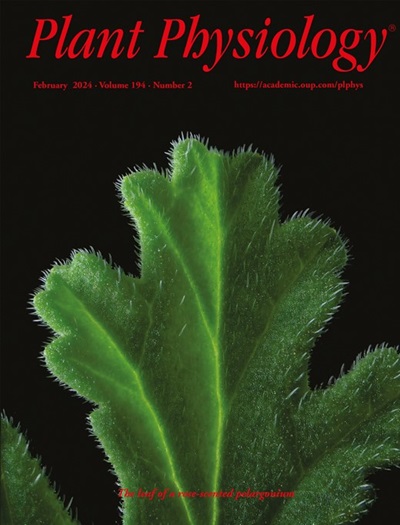CATIONIC AMINO ACID TRANSPORTER 1 modulates amino acid distribution between stem and leaf in new shoots: a case study of theanine distribution in tea plants (Camellia sinensis)
IF 6.5
1区 生物学
Q1 PLANT SCIENCES
引用次数: 0
Abstract
Theanine, a tea plant (Camellia sinensis) -specific non-proteinogenic amino acid, is one of the most important components conferring the taste quality and health benefits of tea. It is primarily synthesized in roots of tea plants and transported to new shoots, where it is mainly distributed to the young stem; however, tea is predominantly produced from young leaves. To promote more theanine allocation to young leaves, the molecular mechanism underlying theanine distribution between stems and leaves requires elucidation. In this study, we found the ratios of stem-to-leaf theanine content in the new shoots of 11 tea plant cultivars ranged from 3.8 to 8.8. Analyses on transcriptome and gene expression demonstrated that the expression of CATIONIC AMINO ACID TRANSPORTER1 (CsCAT1), an amino acid transporter-encoding gene, was highly correlated with the ratios of theanine content in the stem and in leaf (r = 0.97, p < 0.0001). Further analyses indicated that CsCAT1 localizes in the plasma membrane and has theanine transport activity. Moreover, CsCAT1 was predominantly expressed in the vascular ray cells in the stem. Finally, we found that repression of CsCAT1 increased theanine content in young leaves and the ratio of leaf-to-stem theanine content. These results indicate that CsCAT1 modulates theanine distribution between stem and leaf and provides a target for increasing theanine content in young leaves of tea plants.阳离子氨基酸转运蛋白1调节新芽茎叶间氨基酸分布——以茶树茶氨酸分布为例
茶氨酸是茶树(Camellia sinensis)特有的非蛋白质氨基酸,是赋予茶叶口感、品质和健康益处的最重要成分之一。它主要在茶树的根中合成并运输到新枝中,在新枝中主要分布到幼茎中;然而,茶主要是由嫩叶制成的。为了促进更多的茶氨酸分配给幼叶,需要阐明茎叶间茶氨酸分配的分子机制。在本研究中,我们发现11个茶树品种新芽中茎叶茶氨酸含量的比值在3.8 ~ 8.8之间。转录组和基因表达分析表明,氨基酸转运蛋白编码基因CsCAT1的表达与茎叶中茶氨酸含量的比值高度相关(r = 0.97, p <;0.0001)。进一步分析表明,CsCAT1定位于质膜,并具有茶氨酸运输活性。此外,CsCAT1主要在干细胞的血管射线细胞中表达。最后,我们发现CsCAT1的抑制增加了幼叶中茶氨酸含量和叶茎茶氨酸含量的比值。这些结果表明,CsCAT1调控了茶氨酸在茎叶间的分布,为增加茶树幼叶中茶氨酸含量提供了一个靶点。
本文章由计算机程序翻译,如有差异,请以英文原文为准。
求助全文
约1分钟内获得全文
求助全文
来源期刊

Plant Physiology
生物-植物科学
CiteScore
12.20
自引率
5.40%
发文量
535
审稿时长
2.3 months
期刊介绍:
Plant Physiology® is a distinguished and highly respected journal with a rich history dating back to its establishment in 1926. It stands as a leading international publication in the field of plant biology, covering a comprehensive range of topics from the molecular and structural aspects of plant life to systems biology and ecophysiology. Recognized as the most highly cited journal in plant sciences, Plant Physiology® is a testament to its commitment to excellence and the dissemination of groundbreaking research.
As the official publication of the American Society of Plant Biologists, Plant Physiology® upholds rigorous peer-review standards, ensuring that the scientific community receives the highest quality research. The journal releases 12 issues annually, providing a steady stream of new findings and insights to its readership.
 求助内容:
求助内容: 应助结果提醒方式:
应助结果提醒方式:


